With our RX 7800 XT testing out of the way with both the reference card and the XFX overclocked card I can finally jump into the Radeon RX 7700 XT to check out its performance. For this card AMD doesn’t have a reference design so to check out stock clocked performance I’ve got the Sapphire RX 7700 XT Pulse. It has the stock clocks and is Sapphire’s budget friendly card which in the past has combined great performance while avoiding adding in all of the unneeded flashy features you see on higher-end cards including RGB. So I’m going to dive in and check out what Sapphire has done with their card design, and then after that, we can put it through our test suite. When we are done we can then step back and see how it all comes together and where the 7700 XT as well as the 7700 XT Pulse fit into the market.
Product Name: Sapphire RX 7700 XT Pulse
Review Sample Provided by: Sapphire
Written by: Wes Compton
Amazon Affiliate Link: HERE
AMDs new RX 7700 XT and 7800 XT
At Gamescom this year AMD announced two new GPUs to fill in a few big gaps in their current 7000 Series GPU lineup. Before the announcement, they had the RX 7600, RX 7900 XT, and RX 7900 XTX. That covered the higher end of the market with their 4K focused cards and the 7600 which is a mid-range 1080p focused card. The two new models fit in the middle with a 1440p resolution focus. While 1080p is still the most widely used resolution on Steam hardware surveys, the 1440p resolution is growing quickly, AMD highlighted this in the presentation pointing out a 44% growth year on year on the Steam hardware survey.
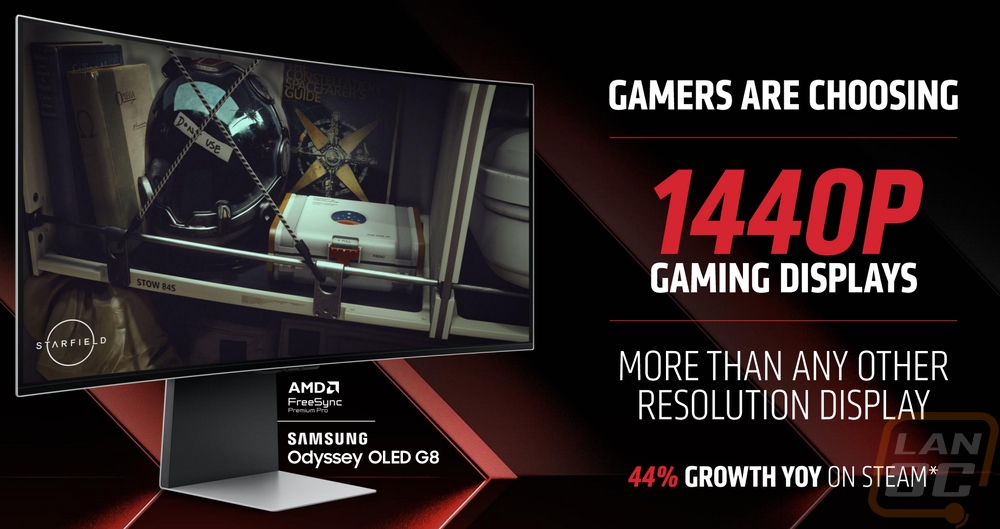
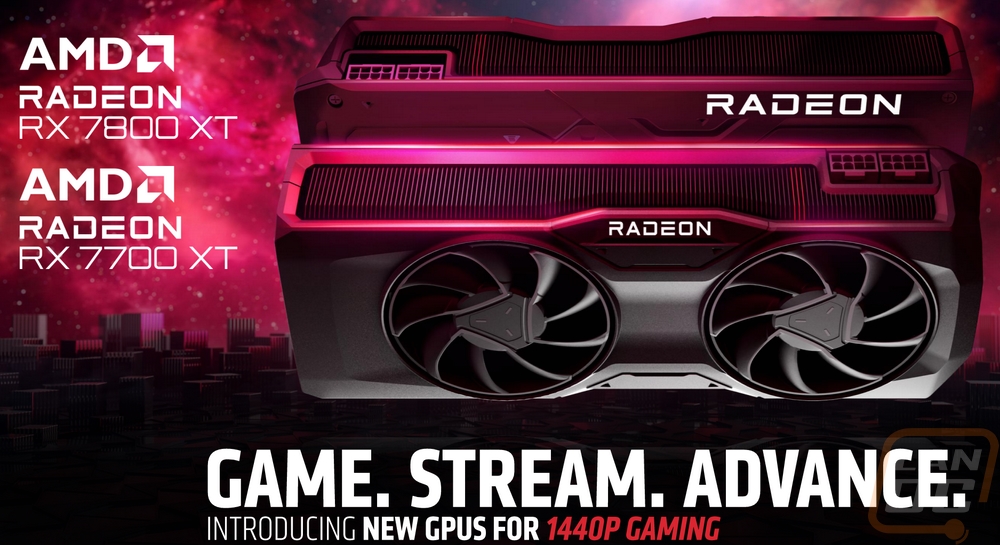
To get a look at where the new RX 7700 XT and RX 7800 XT sit spec wise I have the specs from the AMD briefing as well as a full breakdown that includes the RX 7600 and RX 7900 XT which for the 7000 Series sit above and below the two cards as well as the RX 6700 XT and RX 6800 which are the comparable cards from last generation. Both the 7700 XT and the 7800 XT have the same 5nm and 6nm combination of manufacturing process that the 7900 XT has. The two GPUs have the same die size and transistor count with them sharing the same base GPU but the compute units and the stream processor counts show us that it has been cut down slightly for the 7700 XT compared to the 7800 XT. The 7800 XT is right with the 6800 in stream processors as well as compute units and ray accelerators but last generation's cards didn’t have the AI accelerators which the 7800 XT has 120 and the 7700 XT has 108. The 7800 XT has a slightly lower game GPU clock than the 7700 XT with it at 2124 MHz to 2171 MHz on the 7700 XT. The same goes for the boost clock which the 7800 XT can see up to 2430 MHz whereas the 7700 XT can do up to 2544 MHz. The single precision performance numbers give us an idea of what the lower clock speeds but higher core counts translate to. The 7700 XT can do up to 35 TFLOPS whereas the 7800 XT is slightly higher at 37 TFLOPS. The 7900 XT is way out ahead of that at 51 TFLOPS and the 7600 is well below the two at 21 TFLOPS. Then both the 6700 XT and the 6800 are well below the 7600 at 13.21 TFLOPS and 16.17 TFLOPS.
The 7700 XT has 48 MB of the 2nd generation Infinity Cache whereas the 7800 XT has 64 MB. Then for memory, the 7700 XT has 12GB of GDDR6 memory to the 16GB on the 7800 XT. They also have different memory bus interfaces with a 192-bit interface for the 7700 XT and 256-bit for the 7800 XT and the memory on the 7800 XT is also clocked faster with it running at 19.5 Gbps and 18 Gbps for the 7700 XT. Overall the higher cache and everything else translates to the 7700 XT having an effective memory bandwidth of 1995.3 GB/s to the 2708.4 GB/s for the 7800 XT. Both cards have a traditional PCIe 4.0 x16 interface, not the x8 that the RX 7600 had. Then for power, the two cards do have different total board power ratings with the 7700 XT at 245 watts and the 7800 XT at 263 watts. AMD also announced the base pricing of the cards at Gamescom with the RX 7700 XT at $449 and the RX 7800 XT at $499. The 7800 XT is available in a reference design directly from AMD as well as designs from their partners but the 7700 XT doesn’t have a reference design and will only be available with the partner designs.
|
Specifications |
RX 7600 |
RX 6700 XT |
RX 7700 XT |
RX 6800 |
RX 7800 XT |
RX 7900 XT |
|
Architecture |
RDNA 3 |
RDNA 2 |
RDNA 3 |
RDNA 2 |
RDNA 3 |
RDNA 3 |
|
Manufacturing Process |
6nm |
7nm |
5nm GCD + 6nm MCD |
7nm |
5nm GCD + 6nm MCD |
5nm GCD + 6nm MCD |
|
Transistor Count |
13.3 Billion |
17.2 Billion |
28.1 Billion |
26.8 Billion |
28.1 Billion |
57.7 Billion |
|
Dia Size |
204 mm² |
335 mm² |
200mm² GCD 150mm² MCD |
520 mm² |
200mm² GCD 150mm² MCD |
529 mm² |
|
Compute Units |
32 |
40 |
54 |
60 |
60 |
84 |
|
Ray Accelerators |
32 |
40 |
54 |
60 |
60 |
84 |
|
AI Accelerators |
64 |
-- |
108 |
-- |
120 |
168 |
|
Stream Processors |
2048 |
2560 |
3456 |
3840 |
3840 |
5376 |
|
Game GPU Clock |
2250 MHz |
2424 MHz |
2171 MHZ |
1815 MHZ |
2124 MHz |
2025 MHz |
|
Boost GPU Clock |
Up to 2655 MHz |
Up to 2581 MHz |
Up to 2544 MHz |
Up to 2105 MHz |
Up to 2430 MHz |
Up to 2394 MHz |
|
Peak Single Precision Perf. |
Up to 21 TFLOPS |
Up to 13.21 TFLOPS |
Up to 35 TFLOPS |
Up to 16.17 TFLOPS |
Up to 37 TFLOPS |
Up to 51 TFLOPS |
|
Peak Half Precision Perf. |
Up to 43 TFLOPS |
Up to 26.43 TFLOPS |
Up to 70 TFLOPS |
Up to 32.33 TFLOPS |
Up to 74 TFLOPS |
Up to 103 TFLOPS |
|
Peak Texture Fill-Rate |
Up to 339 GT/s |
Up to 413 GT/s |
Up to 550 GT/s |
Up to 505.2 GT/s |
Up to 583 GT/s |
Up to 804 GT/s |
|
ROPs |
64 |
64 |
96 |
64 |
96 |
192 |
|
Peak Pixel Fill-Rate |
Up to 169 GP/s |
Up to 165.2 GP/s |
Up to 244 GP/s |
Up to 202.1 GP/s |
Up to 233 GP/s |
Up to 459 GP/s |
|
AMD Infinity Cache |
32 MB (2nd Gen) |
96 MB (1st Gen) |
48 MB (2nd Gen) |
128 MB (1st Gen) |
64 MB (2nd Gen) |
80 MB (2nd Gen) |
|
Memory |
8GB GDDR6 |
12GB GDDR6 |
12GB GDDR6 |
16GB GDDR6 |
16GB GDDR6 |
20GB GDDR6 |
|
Memory Speed |
18 Gbps |
16 Gbps |
18 Gbps |
16 Gbps |
19.5 Gbps |
20 Gbps |
|
Effective Memory Bandwidth w/AMD Infinity Cache |
Up to 476.9 GB/s |
Up to 1278.0 GB/s |
Up to 1995.3 GB/s |
Up to 1664.2 GB/s |
Up to 2708.4 GB/s |
Up to 2900 GB/s |
|
Memory Bus Interface |
128-bit |
256*bit |
192-bit |
256-bit |
256-bit |
320-bit |
|
PCIe Interface |
PCIe 4.0 x8 |
PCIe 4.0 x16 |
PCIe 4.0 x16 |
PCIe 4.0 x16 |
PCIe 4.0 x16 |
PCIe 4.0 x16 |
|
Total Board Power |
165W |
230W |
245W |
250W |
263W |
300W |
|
Launch MSRP |
$269 |
$479 |
$449 |
$649 |
$499 |
$899 |
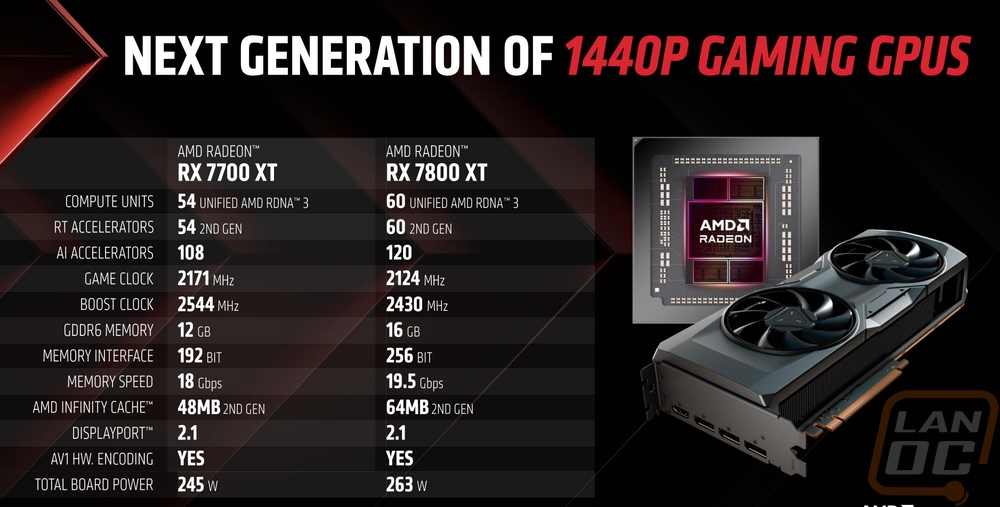
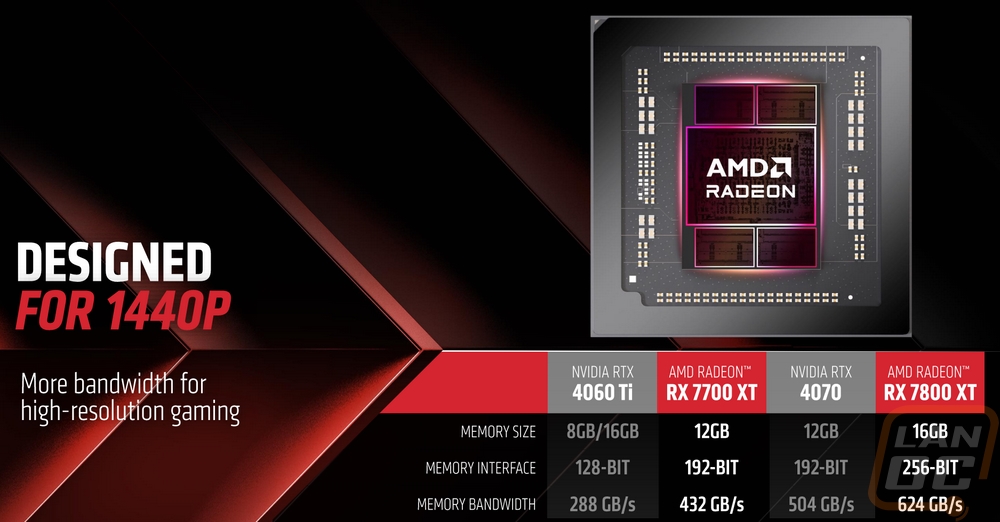
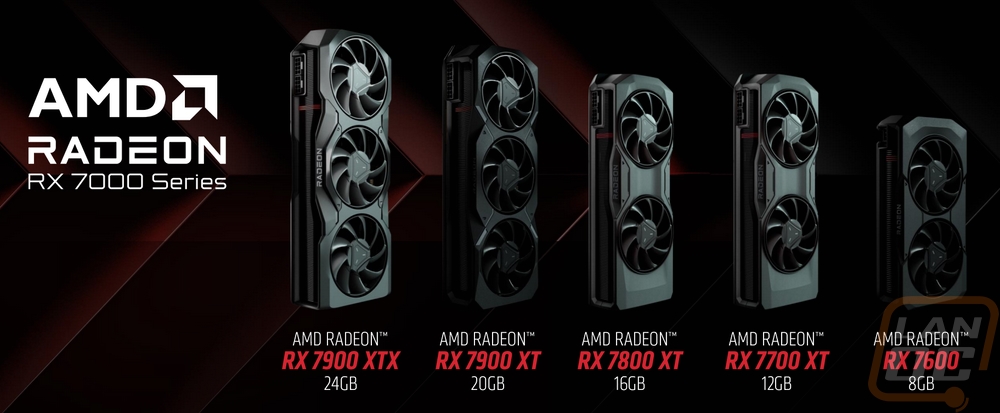
Alongside of the two new cards, AMD also announced their FidelityFX Super Resolution 3 which brings frame generation to AMD cards. Unlike DLSS from Nvidia AMD has this as an open standard so it can not only work with all of AMDs cards, but it can also work with Nvidia cards as well. FSP 3 with upscaling can work with AMD cards back to the RX 590 and Nvidia 10 Series cards but that doesn’t include frame generation. For that, you will need an AMD 5700 or better and RTX 20 Series or higher. They showed off the performance differences that you can see with Forspoken from Square Enix where they were able to go from 36 FPS up to 122 FPS at 4K by using FSR 3 performance mode. FSR 3 has a list of upcoming games and game support of course will make or break this as a feature. The performance is great, but if none of the games you play support It, well that doesn’t help at all. FSR and FSR 2 have 300 games with current or upcoming support so if that is any indication. They also have combined Radeon Boost, Anti-Lag+, and Super Resolution on the driver side into one feature they are calling Hyper-RX which helps make getting better performance easier, with that they showed off some performance improvements you can see with average FPS improving and latency dropping by big margins in all of the games shown.
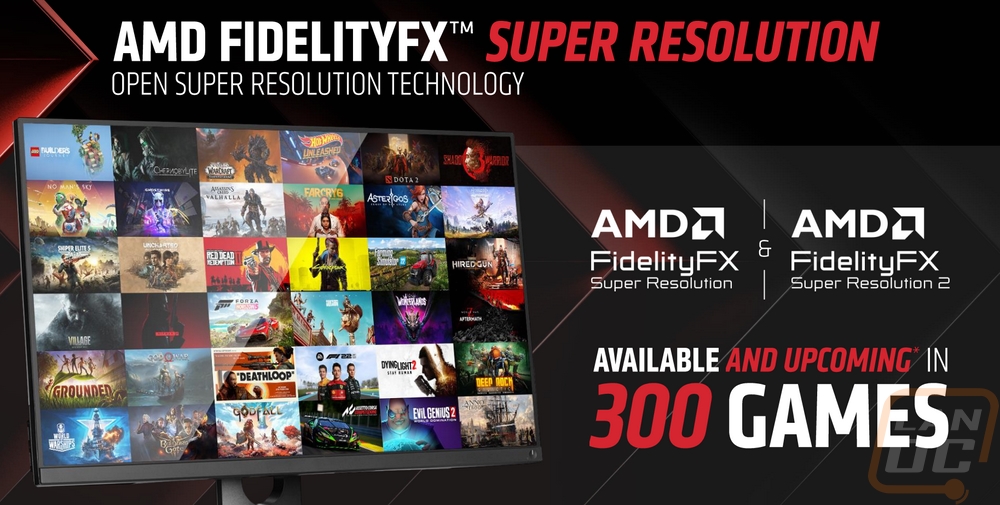
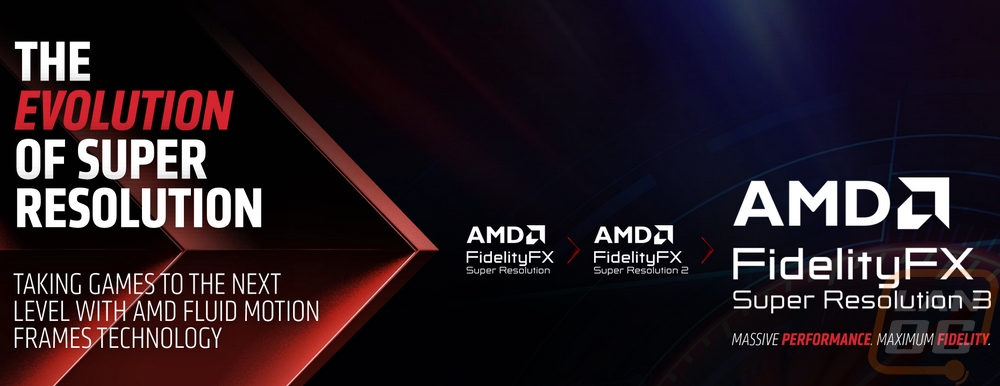
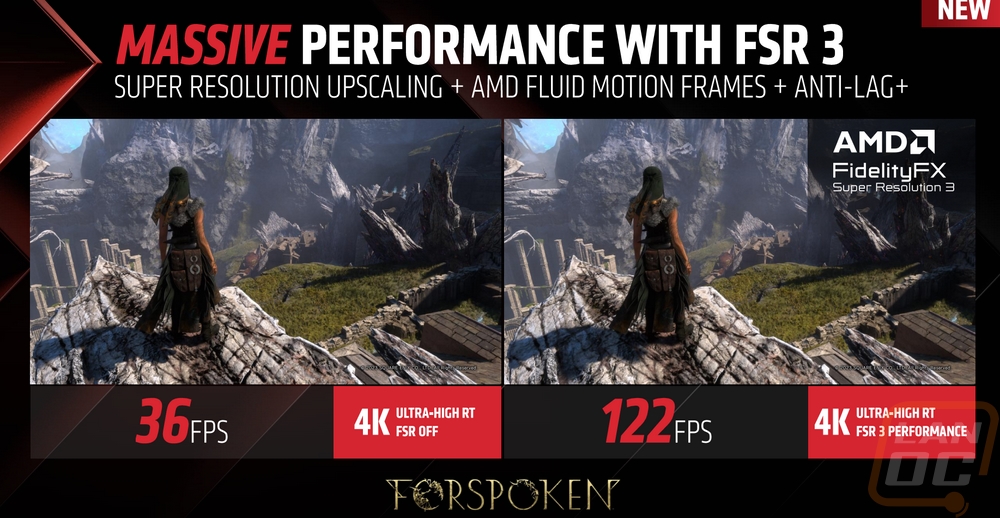
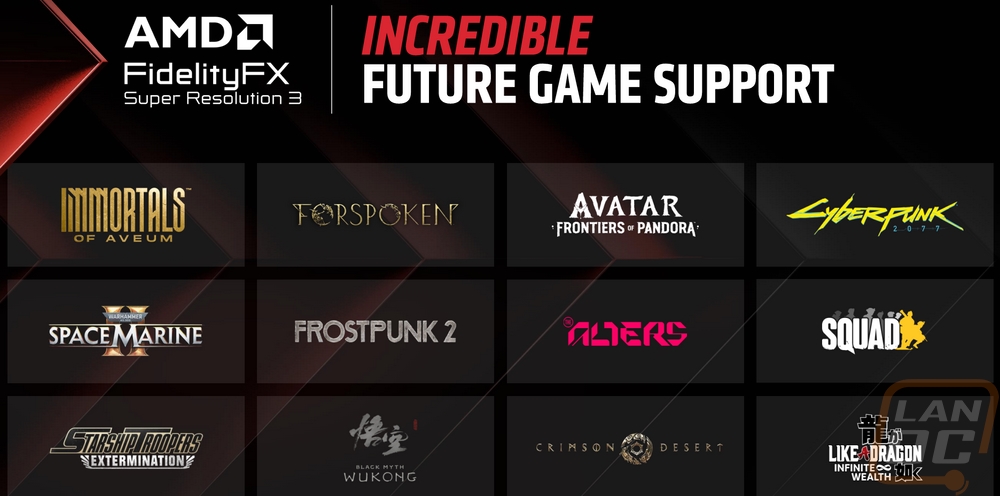
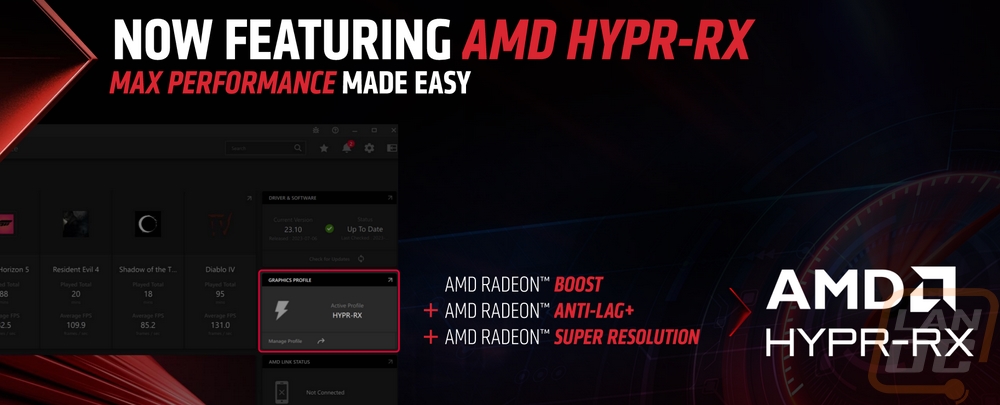
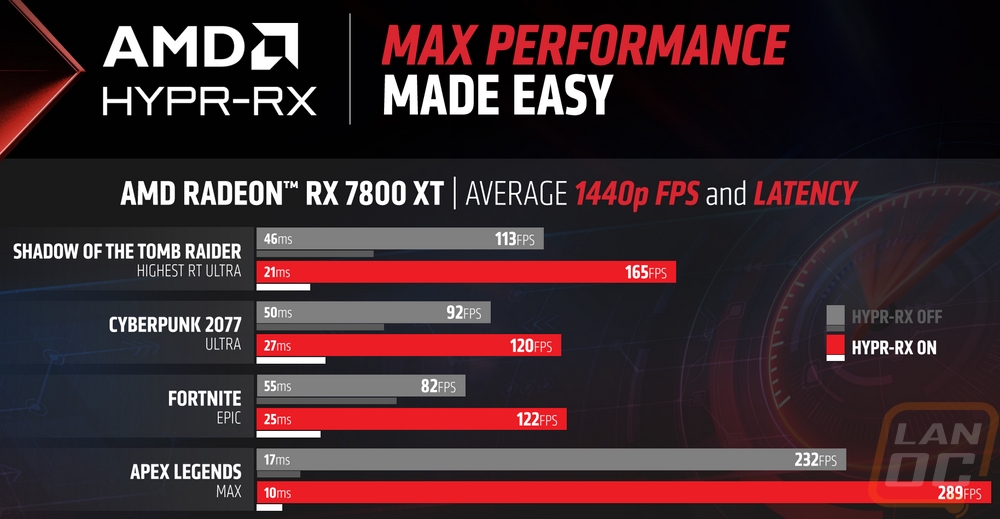
AMD also touched on the streaming capabilities as well on their call. Highlighting AV1 support which is the future of streaming. AV1 can get you higher quality while lowering the bandwidth needs. They also touched on AMDs noise suppression which can help cut out background noise from your microphone.
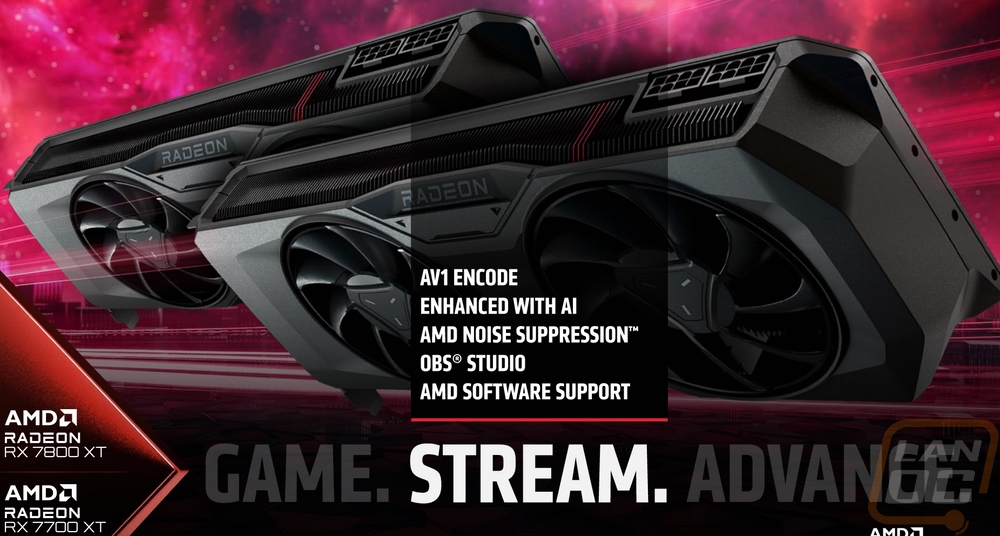
With the RX 7700 XT and RX 7800 XT hitting stores tomorrow September 6th, the cards are also timed to launch the same day as Starfield which utilizes AMDs technology. AMD is also offering a copy of the game to anyone who picks up the 7700 XT or the 7800 XT. This is a great way to add some value to the cards and also make sure everyone has access to a brand new game to check out how your new cards can perform.
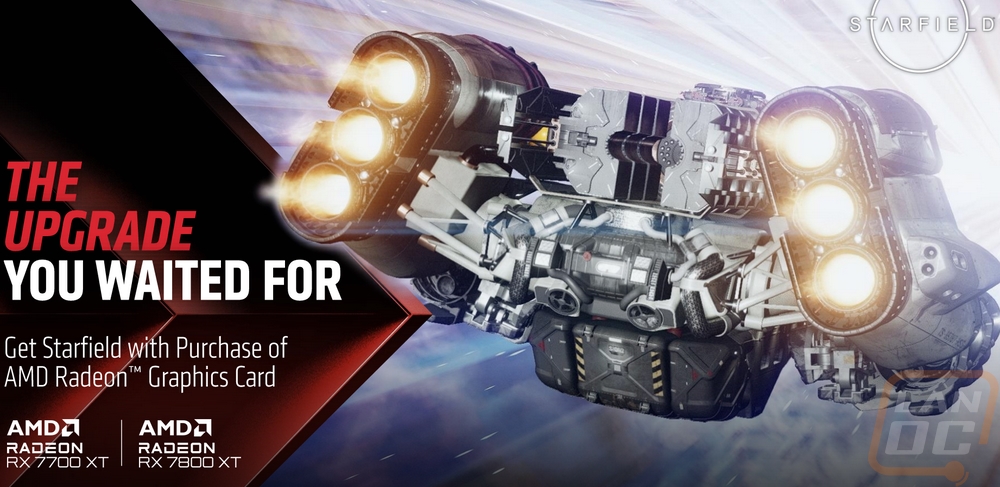
Before getting into testing I did also run GPUz to double-check that our clock speeds matched up with the specifications. The Radeon RX 7700 XT has a game clock speed of 2171 MHz and a boost clock of 2544 MHz, the Sapphire 7700 XT Pulse matches that and isn’t an overclocked card. GPUz confirmed those clock speeds as well. GPUz also documents the driver I tested with which is the Adrenalin 23.20.01.05 driver that AMD provided press ahead of the launch. It also documents the BIOS of the Pulse as well for future reference.

|
Sapphire 7700 XT Pulse Specifications |
|
|
SKU |
11335-04-20G |
|
GPU |
AMD Radeon™ RX 7700 XT Graphics Card 5nm GPU AMD RDNA™ 3 Architecture |
|
Stream Processors |
3456 |
|
Compute Units |
54 CU (with RT+AI Accelerators) |
|
Infinity Cache |
48MB |
|
Ray Accelerators |
54 |
|
Displays |
Maximum 4 Displays |
|
Resolution |
HDMI™: 7680×4320 DisplayPort 2.1: 7680×4320 |
|
Interface |
PCI-Express 4.0 x16 |
|
Output |
2x HDMI 2x DisplayPort |
|
BIOS Support |
UEFI |
|
Game Index |
1440P |
|
Sapphire Features |
Digital Power Design Ultra High Performance Conductive Polymer Aluminum Capacitors Fuse Protection High TG Copper PCB Optimized Composite Heatpipe Dual-X Cooling Technology Intelligent Fan Control Precision Fan Control Metal Backplate Angular Velocity Fan Blade Dual-Ball Bearing Fans TriXX Supported TriXX Boost |
|
AMD Features |
AMD RDNA™ 3 Architecture 54 AMD RDNA™ 3 Compute Units (with RT+AI Accelerators) 48MB AMD Infinity Cache™ Technology DisplayPort™ 2.1Support AMD Radiance Display™ Engine 12GB GDDR6 on 192-bit Memory Bus PCI® Express 4.0 ready AMD FidelityFX™ Super Resolution technology Microsoft® DirectX® 12 Ultimate Support Microsoft® DirectStorage Support Vulkan® Optimized AMD Smart Technologies AMD Software: Adrenalin Edition™ AMD Noise Suppression AMD Privacy View AMD Radeon™ Super Resolution technology AMD Link AMD FreeSync™ technology |
|
Cooling |
2 Fans |
|
Form Factor |
2.5 slot, ATX Dimension: 280(L)X 128.75(W)X 52.57 (H)mm |
|
Power Consumption |
230W Total Board Power |
|
OS |
Linux®, Windows® 10, and Windows 11. 64-bit operating system required |
|
System Requirement |
Minimum 700 Watt Power Supply 2 x 8-pin Power Connector. PCI Express® based PC is required with one X16 lane graphics slot available on the motherboard. Minimum 8GB of system memory. 16GB recommended. |
|
Warranty |
2 years |
Packaging
The packaging for the Sapphire RX 7700 XT Pulse sticks right with what we have seen in the past for Sapphire cards but they did change the color up from the RX 7600 Pulse that I took a look at back in May which has a yellow/brown. The background doe the 7700 XT Pulse is a bright purple and because of that the red wrap-around that AMD has all of their partners include blends in a little better as well. The background has the pulse oximeter like pulse line leading to the Sapphire Pulse logo on the right. Sapphire has a second Sapphire logo up in the top left as well. Then the GPU model information is in the red wrap-around as well as the 12GB of VRAM in the bottom left. The back of the box changes things up completely with a bright white background. They have the Model name in the top left and the pulse zig-zag line runs across the back but there isn’t really any useful information back here. They have some product specifications and by some I mean it lets you know this card has two DisplayPort and two HDMI connections. They also let you know their power requirements. But the card dimensions would be nice and a few pictures of the card would be helpful if shipping in retail as well.


The outer box slides off once you cut the seal and inside is a brown box that gives most of the structure. The brown box opens up and inside is a half-inch layer of foam on top. Under that you have the documentation then the 7700 XT Pulse comes wrapped in a static protective bubble wrap bag and is then sitting in a thick foam tray cut out to fit the card. The card also has plastic you have to peel off on the fan shroud as well. For documentation, you get a basic generic quick installation guide and that’s about it. The Pulse lineup isn’t about including any more than you need so there aren’t any adapters, brackets, or swag included.



Card Layout and Photos
The Sapphire RX 7700 XT Pulse looks very similar to the RX 7600 Pulse that I recently took a look at, their fan shrouds have the same styling. It has a dual fan configuration and a black plastic fan shroud that wraps around partially on all of the edges to help contain the airflow from the two fans. The shroud then has small red and black accents printed on it, mostly in the center between the two fans but there is one on each end that goes out past the fans as well. Being a Pulse card, Sapphire doesn’t do anything crazy for styling and the RX 7700 XT Pulse has no lighting at all which I know a lot of people will like. Beyond those red accents and a touch of red in the center of the fans, most of the card is blacked out.


In a world where it seems like almost every non-reference card is huge the RX 7700 XT Pulse keeps things at least slightly restrained down to a size closer to what a large card was a few years ago. It is 280 mm long and 128.75 mm tall. That does put it around 18 mm over the top of a standard PCIe card but with recessed power connections that space would already be used for the power plugs, so fitment in most cases shouldn’t be an issue. It is 52.57 mm thick which is a little past being a 2.5-slot card, they are using a 2-slot PCI bracket so you can see the fan shroud sticking up through the middle for that extra half-slot.



Where the 7600 Pulse and the RX 7700 XT Pulse differ however are with the fans. The RX 7700 XT Pulse has Sapphire's newer fan design which are almost 100 mm for the fan openings and 92 mm wide from edge-to-edge on the blades themselves. Both of the fans are also the exact same. They have 9 blades and each blade has a unique looking angular look to them. Sapphire calls this their Angular Velocity Fan Blade and they claim that it gives a double layer of downward air pressure, improving air pressure by 44% and giving 19% more airflow. Then on the outside edge, all of the blades are linked together with an outer ring to give them strength. The fan centers have a spun aluminum finish which is tinted darker to match the card and a small red ring on the outside along with the Sapphire Pulse logos on each. Through the fans, we can see the aluminum sheet metal heatsink with a vertical orientation behind them. The two fans blow down into the card and up out the top and down and out the bottom of the card.



The top edge of the has both the fan shroud and the backplate wrapped around on to it. On the PCI bracket end of the card, it has a red Radeon logo and the Sapphire logo in white on a red background. Then an inch away from the end of the card where the PCB ends the RX 7700 XT Pulse has two 8-pin PCIe power connections. This means that the RX 7700 XT Pulse doesn’t require a 12VHPWR compatible power supply or adapter, which means you can save money there if you already have a power supply.


Looking around at the edges we get a much better look at Sapphire's cooler design. The heatsink is split into two separate heatsinks with an inch-wide gap in the middle where the heatpipes can move around and up, beind the left fan is the GPU itself, the heatpipes run from there and help spread the heat out across the card. The top edge view shows that the fan shroud and backplate do wrap around covering up a lot of the card, but the backplate does have extra ventilation holes cut into it to help compensate. The top view also shows us that there is a lot of room between the heatsink and the PCB with the right fan, you can see all the way through the card which is rare and seems like wasted space. The end of the card has a small opening but it mostly just gives us a peak at the end of the heatsink with the four heatpipes that run to this end of the card. The wrapped around part of the backplate on the end here does have four mounting screw holes where you can support the card with a bracket if needed. The bottom edge of the fan shroud has the model information and your serial number all on stickers, hidden away. This side also gives us a great view of the heatspreader on top of the GPU and memory as well as the heatpipes that sit on top of it.





The backplate design on the RX 7700 XT Pulse is similar to the RX 7600 Pulse but doesn’t have the blow-through design on the end. The PCB on the RX 7700 XT Pulse runs almost to the end of the card so there isn’t room for that. The backplate has a black textured finish which is slightly glossy when you get lights on it. They have the Pulse logo on there in white and red and flipped upside down so it can be read when installed in a traditional case layout. There is also the Radeon branding in red and the zip-zag pulse line down the middle of the card. The backplate does have multiple cutouts in it even without a blow-through section. The bracket and back of the GPU are cut around to keep them exposed. Then up on the top edge, they have a cutout for the power connections which are down at the PCB and 20 mm below the top of the card. That section along the top also has triangle cutouts the length of the card to leave more room for air to flow out of the top of the card.



For display connection options Sapphire has done things a little different from what you will see on most cards. They have two HDMI and two DisplayPort connections with the two HDMI on the top/left and the DisplayPorts on the bottom/right. The PCI bracket does have a section of angled slots for ventilation even though the card doesn’t push air in this direction. Then down at the bottom, they have the Sapphire branding.

Test Rig and Procedures
CPU: Intel Core-i9 13900K – Live Pricing
PL1=PL2: 253, τ: 56 / 307A
Motherboard: Asus Z790 Extreme – Live Pricing
Cooling: Corsair H100i Elite LCD Display - Live Pricing
Noctua NT-H1 Thermal Paste - Live Pricing
Memory: Crucial 32GB Kit (2 x 16GB) DDR5-5600 UDIMM– Live Pricing
Storage: Sabrent Rocket Q4 2TB – Live Pricing
Power Supply: be quiet! Dark Power Pro 13 1600W- Live Pricing
Case: Primochill Wetbench - Live Pricing
OS: Windows 11 Pro 64-bit - Live Pricing
|
Our Testing Procedures |
|
|
3DMark |
All 3DMark-based tests are done using the most recent version. We test using all three versions of Fire Strike, Both Time Spy and Time Spy Extreme, and Speed Way. Tests to look at ray tracing performance are done with Port Royal when supported and for Nvidia cards that support DLSS, the DLSS subtest is also done at 1440p with the performance setting and DLSS 2.0 as well as a look at DLSS 1, 2, and 3 at 4K. |
|
Unigine Superposition |
1080p Extreme and 4k Optimized benchmarks along with the VR Future test are done. The VR test is done at the Oculus resolution |
|
VRMark |
Only the Blue room test is run |
|
CS:GO |
This test is done using the workshop map called CS:GO Benchmark. You can find more information at this link. https://www.gamingpcbuilder.com/how-to-install-csgo-fps-benchmark-map/ I test at 1080p, 1440p, and 4K resolutions. All auto settings are turned off and detail is set to their highest settings. shadow quality high, model texture detail high, shader detail very high, AA set to 16x, uber shaders enabled |
|
Ghost Recon Breakpoint |
Built-in benchmark tested at 1080p, 1440p, and 4k with the Ultra and Medium detail settings |
|
Watch Dogs: Legion |
Built-in benchmark testing at ultra and high details. Tested at 1080p, 1440p, and 4k. I also do RTX and DLSS testing on Nvidia cards at 4K using the Ultra detail settings as a base as well. |
|
Borderlands 3 |
Built-in benchmark testing with the ultra detail setting and medium detail setting, done at full screen with default settings at 1080p, 1440p, and 4k on DX11 |
|
Metro Exodus |
Using built-in benchmark, testing at ultra and normal details at 1080p, 1440p, and 4k. I also do RTX and DLSS testing at 4K with the ultra-detail base settings for Nvidia cards as well. |
|
World War Z Aftermath |
Built-in benchmark in DX11 testing both the Ultra detail and Medium detail levels at 1080p, 1440p, and 4K resolutions |
|
The Division 2 |
Built-in benchmark at Ultra detail with V-Sync turned off at 1080p, 1440p, and 4k resolutions. |
|
Total War: Three Kingdoms |
Built-in benchmark using the Battle Benchmark setting. Tested at 1080p, 1440p, and 4k at both high and ultra detail settings |
|
Far Cry 6 |
Built-in benchmark tested at 1080p, 1440p, and 4k with the Ultra and Medium detail settings |
|
V-Ray 5 |
V-Ray 5 benchmark us run with CUDA and RTX settings on cards that support it |
|
Boundary Benchmark |
Testing different DLSS detail levels on cards that support it. All testing is done at 4k with RTX on |
|
Bright Memory Infinite RTX Benchmark |
Benchmark all of the different RTX detail levels. Resolution at 4k and DLSS on balanced for each test |
|
Passmark Performance Test 10.2 |
Test using the GPU Compute Score inside of PassMark's Performance Test 10.2 |
|
Blender |
Using the standard Blender Benchmark I run the test using the Blender 3.4 setting which tests using the Monster, Junkshop, and Classroom tests. |
|
OctaneBench 2020.1 |
OctaneBench is designed to test rendering in OctaneRender. RTX and non-RTX are both ran. This is a CUDA-only test so only Nvidia cards are tested |
|
Power Testing garage |
Using a PCat v2 to monitor power between the PCIe slot and the card as well as power through the power cables I test the peak power when running ADIA64, 3DMark Speed Way, 3DMark Time Spy Extreme, FarCry 6 at 4k and Ultra Detail, Watch Dogs Legion at 4K and Ultra detail, and Blender 3.4.0. The results are then averaged as well as the highest result. |
|
Noise Testing |
Our Noise testing is done using a decibel meter 18 inches away from the video card on the bottom/fan side of the card. We test at 50% and 100% fan speeds as well as a third test while under load using AIDA64's stress test. This is done using a Protmex PT02 Sound Meter that is rated IEC651 type 2 and ANSI S1.4 type 2. Tests are done set weighted to A and set to a slow response using the max function. The ambient noise level in the testing area is 33.3 decibels. |
|
Temperature Testing |
Using AIDA64, the GPU stress test is run for 30 minutes or until the result has leveled off. The test is run twice, once with the stock fan profile and a second time with 100% fan speed. During this, I also document the 100% fan speed RPM and document the delta between the fan profile and 100% fan speed as well as get thermal images. |
Synthetic Benchmarks
As always I like to start my testing with a few synthetic benchmarks. 3DMark especially is one of my favorites because it is very optimized in both Nvidia and AMD drivers. It's nice to not have to worry about it being favored too much either way and the repeatability of the results makes it a nice chance to compare from card to card, especially when comparing with the same GPU. The RX 7700 XT Pulse is the first 7700 XT we are checking out, but I do want to see how it compares to the 7800 XT that has also launched as well as the RTX 4060 Ti from Nvidia and AMD's previous generation with the RX 6750 XT as well.
The first round of tests were done in the older Fire Strike benchmark which is a DX11 test. There are three detail levels, performance, extreme, and ultra. The RX 7700 XT Pulse scored 42005 in the base Fire Strike benchmark. This put it right in the middle of two RTX 4070 and with that, it is of course also ahead of the 4060 Ti. The 6750 XT is also behind it as well. Going up to Fire Strike Extreme the 4070 moved up but the RX 7700 XT Pulse is still out ahead of the 6750 XT by a good margin then at Fire Strike Ultra the RX 7700 XT Pulse is back out in front of all of the RTX 4070.



The next two were both based on the Time Spy benchmark. One is the standard test and then there is the extreme detail level. For Time Spy the RX 7700 XT Pulse scored a 16812 which put it right in between last generations RTX 3080 and the 3070 Ti. The RX 7700 XT Pulse is 22% ahead of the 6750 XT. The Time Spy Extreme results were similar with the RX 7700 XT Pulse sitting between the 3070 Ti and the 3080/4070.


For ray tracing performance, I ran both the 3DMark Port Royal test which is ray tracing focused as well as the new 3DMark Speed Way test which tests all future-looking features including ray tracing. In Speed Way, the RX 7700 XT Pulse comes in behind the RTX 4060 Ti 8GB and ahead of the older 3060 Ti. It is however way out in front of the 6750 XT, so while not on par with Nvidia’s Speed Way performance AMD has made improvements this generation over the last generation. In Port Royal, the RX 7700 XT Pulse is just ahead of the 3070 Ti and way ahead of the 4060 Ti 8GB.


I did also want to check out the FSR 2 performance of the RX 7700 XT Pulse, for that I ran the performance comparison in 3Dmark putting it against the other 7000 Series cards for comparison. This isn’t about card-to-card performance though, I was mostly looking to see the kind of performance that FSR 2 can offer. Without FSR 2 at all the RX 7700 XT Pulse averaged 21.97 FPS, turning it on at the highest quality was enough to almost double that to 43.14 FPS. From there the balanced and performance quality options improved on that even more up to 51.34 FPS and 64.68 FPS then the ultra-performance setting jumps way up to an impressive 101.32 FPS.

The last test was using the Unigine-based Superposition benchmark and I tested at 1080p with the extreme detail setting as well as the 4K optimized setting. In the extreme detail setting the RX 7700 XT Pulseis sitting below the RTX 3070 Ti and ahead of the RTX 3070 once again which puts it out in front of the RX 6750 XT and 4060 Ti but with a big gap between it and the RTX 4070s which are in a big group above the 3070 Ti.

VR Benchmarks
As for Virtual Reality, I love it but it is more demanding than traditional gaming. This is partially because of the resolutions needed to render for two eyes and because they render more than what is immediately visible. But also because of post effects to get the proper “fisheye” effect for it to look proper in your eyes with the HMD. You also have to have much higher expectations for frame rates in VR, skipping frames or lower FPS can cause motion sickness in VR. Because of that, I ran a few tests.
My first test was again in Superposition. This time I tested the VR Future test using the Oculus resolution. I have also included the average frame rate as well which is important for the cards at the top of the chart because for some reason Superposition is capped at 10,000 for its scores and that doesn’t show the performance gap in those cards at the top. The RX 7700 XT Pulse is sitting right in the middle of two different RTX 4070s. This put it out in front of the 3070 Ti and way ahead of the 4060 Ti and 6750 XT.

My second round of VR testing was in VRMark which has three tests that are similar to the VR tests in Superposition. I only focused on just the most demanding test called Blue Room which is looking more at future VR performance. The RX 7700 XT Pulse was nearly tied with the RTX 3070 Ti here with a big gap between both cards and the 4070s ahead of them and an equally large gap between them and the 6750 XT and 4060 Ti.

In-Game Benchmarks
Now we finally get into the in game performance and that is the main reason people pick up a new video card. To test things out I ran through our new benchmark suite that tests 10 games at three different resolutions (1080p, 1440p, and 4k). Most of the games tested have been run at the highest detail setting and a mid-range detail setting to get a look at how turning things up hurts performance and to give an idea of if turning detail down from max will be beneficial for frame rates. In total, each video card is tested 48 times and that makes for a huge mess of results when you put them all together. To help with that I like to start with these overall playability graphs that take all of the results and give an easier-to-read result. I have one for each of the three resolutions and each is broken up into four FPS ranges. Under 30 FPS is considered unplayable, over 30 is playable but not ideal, over 60 is the sweet spot, and then over 120 FPS is for high refresh rate monitors.
So how did the RX 7700 XT Pulse do? Well, first we should understand that AMD is targeting this card for 1440p, just like the 7800 XT. So my expectations for 4K performance were low but it does have 10 out of the 16 results sitting up over 60 FPS which isn’t bad at all. One of those is also up over 120 FPS, then there were 6 results in the 30-60 FPS range which is still playable but not ideal. At 1440p all of the results for the RX 7700 XT Pulse were over 60 FPS but at 11 a majority were over 120 FPS and one (CS:GO) was over 240 FPS as well. Then at 1080p, everything was once again up over 60 FPS, no surprise there but only one result was in the 60-119 FPS range with the rest up over 120 FPS, and 3 of those were even up over 240 FPS.



Of course, I have all of the actual in game results as well for anyone who wants to sort through the wall of graphs below. But to help digest everything I also have averaged out all of the results except for the CS:GO results at all three resolutions for the RX 7700 XT Pulse and a list of cards in that same range. The 1080p results aren’t really useful at all with a lot of those running into CPU-limited issues. But at 1440p and 4K the picture is really clear. The RX 7700 XT Pulse sits in between the RTX 4070 and the RTX 3070 Ti when it comes to gaming performance though at 4K it does drop down closer to the 3070 Ti. With the RTX 4060 Ti, I don’t have a 16GB card for direct comparison which with Nvidia’s price drop has that 16GB card priced to compete with the RX 7700 XT, but with the 8GB version at least it isn’t even close in performance. The main graphs mostly just show that same picture but there are a few games like Ghost Recon where the RX 7700 XT Pulse performs above its weight class, outperforming the RTX 4070.
|
|
1080p |
1440p |
4K |
|
XFX MERC 319 RX 6800 XT |
197.1 |
162.3 |
92.4 |
|
XFX Merc 319 7800 XT Black |
194.0 |
161.0 |
93.3 |
|
Radeon RX 7800 XT |
190.7 |
156.3 |
89.3 |
|
Nvidia RTX 4070 FE |
190.6 |
147.6 |
83.5 |
|
Sapphire RX 7700 XT Pulse |
178.1 |
137.5 |
74.7 |
|
Nvidia RTX 3070 Ti FE |
165.8 |
125.7 |
72.9 |
|
Sapphire Nitro+ RX 6750 XT |
165.2 |
119.4 |
64.5 |
|
Nvidia RTX 3070 FE |
160.9 |
118.8 |
67.2 |
|
Nvidia RTX 4060 Ti 8GB FE |
160.1 |
115.3 |
62.0 |
|
Zotac RTX 4060 Twin Edge OC |
135.7 |
94.5 |
50.1 |
















Compute Benchmarks
Now some people don’t need a video card for gaming, they need the processing power for rendering or 2D/3D production, or in some cases, people who game also do work on the side. So it is also important to check out the compute performance on all of the video cards that come in. That includes doing a few different tests. My first test was a simple GPU Compute benchmark using PassMark's Performance Test 10 and the RX 7700 XT Pulse scored a 15812. This put it in behind the 7800 XT and in front of the 4060 Ti 8GB.

Blender is always my favorite compute benchmark because the open-source 3D rendering software is very popular and it isn’t a synthetic benchmark. With the latest version of Blender, they redid the benchmark so we now have a new test that runs three different renderings and gives each a score. I have all three stacked together so we can see the overall performance. The RX 7700 XT Pulse sits behind the 7800 XT in both 3.5 and 3.6. In the 3.5 results the RX 7700 XT Pulse is ahead of the RTX 3050 and way down in the chart with Nvidia pretty much dominating things. All of the AMD cards really struggle in Blender and that isn’t any different for the RX 7700 XT Pulse.


Cooling Noise and Power
For my last few tests, rather than focusing on in game performance, I like to check out other aspects of video card performance. These are also the most important ways to differentiate the performance between cards that have the same GPU. To start things off I took a look at power usage.
For this, our new test setup utilizes the Nvidia-designed PCat v2 along with cables to handle both traditional 6 or 8-pin connections as well as the new 12VHPWR. The PCat also utilizes a PCIe adapter to measure any power going to the card through the PCIe slot so we can measure the video card wattage exclusively, not the entire system as we have done in the past. I test with a mix of applications to get both in game, synthetic benchmarks, and other workloads like Blender and AIDA64. Then everything is averaged together for our result. I also have the individual results for this specific card and I document the peak wattage result as well which is almost always Time Spy Extreme. The RX 7700 XT Pulse averaged 248 watts and peaked at 290 watts. This put it just above the RTX 3070 and 46 watts lower than the Radeon RX 7800 XT. For comparison, the RTX 3070 Ti that the RX 7700 XT Pulse outperformed in game averaging 308 watts but all of the newer RTX 4070s that are faster than the RX 7700 XT Pulse are down in the low 200 watts. So the RX 7700 XT Pulse is more efficient than last generation Nvidia cards but is behind the current generation.


With having exact peak wattage numbers when running Time Spy Extreme I was also able to put together a graph showing the total score for each watt that a card draws which gives us an interesting look at overall power efficiency in the popular and demanding benchmark. This paints the same pictures that I was just saying. The RX 7700 XT Pulse is just behind the 7800 XT in efficiency and ahead of the RX 7600 but when compared to what Nvidia has going on it is way ahead of any of the 3000 Series but behind even the lowest efficiency 4000 Series cards.

My next round of tests were looking at noise levels. These are especially important to me because I can’t stand to listen to my PC whirling. Especially when I’m not in game and other applications are using the GPU. For my testing, though I first tested with the fan cranked up to 100% to get an idea of how loud it can get, then again at 50% to get an idea of its range. At 50% fan speed the RX 7700 XT Pulse falls right in the middle of the cards tested at 41.7 dB but is down at the bottom of the chart at 100% fan speed which is interesting. At 100% fan speed the two fans were running at 2942 RPM which was also down on the low end of the charts which helps explain why it did so well.



I also take a look at noise performance while under load. For that when running AIDA64’s stress test I wait until the temperature of the card has leveled off and then measure how loud things are when the card is at its worst-case scenario with the stock fan profile. Here the RX 7700 XT Pulse didn’t do as well, in fact, it is up above the halfway point at 41.2 decibels which is close to what it did at 50% fan speed. That makes sense though, the RX 7700 XT Pulse was running at 47% fan speed when under load. Overall this is still a lot better than any of the reference cards including the 7800 XT which was up near the top of the chart. So while the RX 7700 XT Pulse isn’t a top performer, it is better than what a reference card would have done if AMD had made one.


To finish up my testing I of course had to check out the cooling performance. To do this I ran two different tests. I used AIDA64’s Stress Test run for a half-hour each to warm things up. Then I documented what temperature the GPU leveled out at with the stock fan profile and then again with the fans cranked up to 100%. With the stock profile, the RX 7700 XT Pulse ran at 55c which is better than I expected and down in the bottom end of the chart. This also tells us that the previous under-load noise levels could be improved with a small tweak to the fan profile. As for GPU Hotspot, with the stock fan profile that was warmer running at 91c. Crankng the fan speed up to 100% the RX 7700 XT Pulse ran cooler at 46c and the GPU Hotspot dropped down to 77c. This puts the delta between the stock fan profile and 100% fan speed at 9c meaning there is plenty of room left in the cooler if needed but to do that you will have to sacrifice even more noise. I personally would likely be adjusting it the other way and letting the card run a little warmer to have the fans run a little quieter while in game.




While running the stock fan profile testing I also took the time to get a few thermal images so we could see what is going on. The fan side of the 7700 XT Pulse with its plastic fan shroud doesn’t retain much of the heat generated in the fan shroud. Most of the heat on this side can be seen behind the fans and venting out the top and bottom of the card. The hottest spots on the fan sides reach up to 35.6c and as cool as 23.1c which is basically room temperature in my office. On the top edge, it runs at 32.3c and 34.1c on the ends but the center has most of the heat with the hottest spot at 45.6c which is still a lot lower than most cards. Then on the back, the metal backplate does pull some of the heat out as you can see with that running up to 43.4c itself. Then in the center with the cutout around the back of the GPU is the hottest area on the entire card at 58.2c.



Overall and Final Verdict
Our look at the Sapphire RX 7700 XT Pulse is both a look at AMDs new 7700 XT GPU and at Sapphire card design as well. For the 7700 XT AMD has opted to not do a reference design so budget-focused cards like the RX 7700 XT Pulse are as close as you are going to get. They don’t have the all-metal fan shroud but Sapphire’s design is a great example of everything you need and nothing else. The Pulse card design isn’t bad looking and other than a few small accents printed on the shroud you aren’t getting a crazy over top design or any lighting at all. Not having lighting is going to be a big plus for some people and a downside for others. The overall card size isn’t as compact as some of the reference designs, but once you figure in your power connections on top the RX 7700 XT Pulse should fit in any of the same situations. It also uses standard PCIe power connections which means you won’t need to upgrade to a newer ATX 3.0 power supply if you already have one and can avoid the 12VHPWR adapters as well.
For performance, the RX 7700 XT Pulse isn’t sitting at the top of AMDs 1440p product stack but it does have solid 1440p performance. If anything at 1440p, unless you are trying to game at 240hz you won’t see much of a sacrifice compared to the 7800 XT, you lose 4K performance more than anything between the two cards. The RX 7700 XT Pulse leaves the RTX 4060 Ti in the dust for performance and even outperforms the RTX 3070 Ti as well as AMDs 6750 XT. It does have the same Blender performance issues that all of the AMD cards have. Its ray tracing performance is still behind where Nvidia is right now but AMD has made improvements there so the gap is smaller. Sapphire’s card design was quiet at 100% fan speed but when I got into the noise tests when under a normal load it was louder than I expected it to me, after seeing its cooling performance the fan profile could be tweaked slightly to even this out.
As for pricing, Sapphire has the RX 7700 XT Pulse priced at $449 which is right with AMDs RX 7700 XT MSRP, and the Pulse is the perfect card for an MSRP card with its stock clock speeds and only what you need design. But how does AMDs MSRP compare with the competition? Well if we are looking at just current generation cards from AMD and Nvidia the RX 7700 XT Pulse sitting at $449 the RTX 4060 Ti 8GB can be found at $399 and Nvidia has lowered the 16GB card down to $449. We don’t have a 16GB card to compare with but the RX 7700 XT Pulse as a whole was well ahead of the 4060 Ti. Nvidia’s last gen cards like the RTX 3070 and RTX 3070 Ti get a little closer in performance but the RX 7700 XT Pulse was still ahead and while you can find a 3070 Ti at the same $449 price point they don’t completely line up. The RX 7700 XT Pulse gets the strongest competition from AMDs own cards with the 6800 XT that can be found for $499 and the 7800 XT as well at that same price. The pricing between the 7700 XT and the 7800 XT being so tight makes things tough as well once you start looking at any overclocked cards. They didn’t leave much room for a more premium 7700 XT to fit in at all. The 7700 XT Pulse also comes with a copy of Starfield Premium Edition as well which at a $99 value helps a lot if you were already considering getting the game.


Live Pricing: HERE




